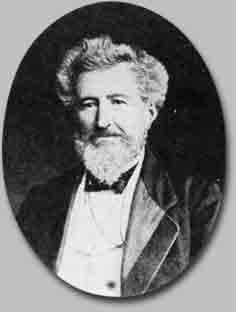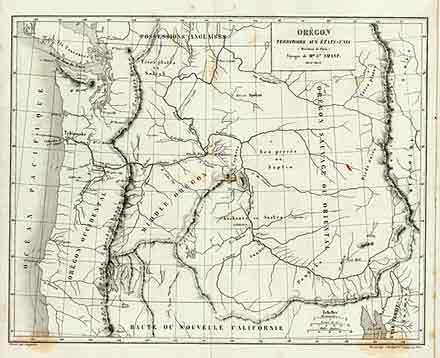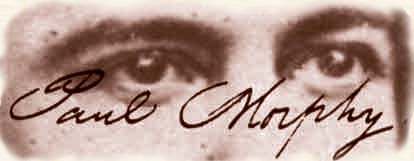|
Pierre Charles
 Fournier
de Saint Amant Fournier
de Saint Amant
(also written:
Pierre Charles-Fournié de Saint-Amant)
After the death of Bourdonnais, the mantle of leading chess player of
France fell upon the shoulders of Pierre Charles Fournier de Saint Amant.
Saint Amant was born in Château Latour in the Bordeaux region of France on
September 9, 1802. During his life he was a wine merchant, a clerk,
an actor, an explorer, a diplomat and the French (and possibly the world)
chess champion.
He learned chess from his mentor Wilhelm (William) Schlumberger.
Not a whole lot is known of Schlumberger. He was
born in Mulhouse in Alsace region of France where the Schlumberger
family operated a largely winery that is in operation today. They also
were industrialists who operated fabric mills in the area. Schlumberger
was a leading French player (his German name comes from the fact that
Alsace lies next to Germany and has often changed alliances throughout
history between France and Germany. During Schlumberger's life, Alsace
was French.). He's best known for his chess in America where arrived in
October 1, 1826 under a contract to operate Maelzel's automaton, the
Turk. He was the Turk's last operator (previous operators during its
European tour had been Johann Allgaier in Germany, Aaron Alexandre
Boncourt and Weyle in
France, Peter Unger Williams, William Lewis and Jacques-Francois Mouret in England). Surprisingly, he was to replace
an young French woman who, for lack of chess players in America, was the
operator when the Turk premiered on April 13, 1826 at the National
Hotel, l12 Broadway, NY. She was only capable of playing pre-established
endgames.
Schlumberger had his own peculiar experiences. He almost gave away the
secret of the Turk when some school boys reportedly saw him exiting the
cabinet after an exhibition. Then on January 30 and 31, 1827, the Turk
placed a game against a certain Mrs. Fischer. Mrs. Fischer won the game.
After the game Maelzel explained that the Turk had only ever lost three
games; once in Paris, once in Boston and by Mrs. Fischer in
Philadelphia. The game, published in the newspapers, was possibly the
first published game by an American woman chess player.
Edgar Allen Poe wrote in his famous
exposé of the Turk:
"There is a man, Schlumberger, who attends him wherever he goes, but
who has no ostensible occupation other than that of assisting in the
packing and unpacking of the automaton. This man is about the medium
size, and has a remarkable stoop in the shoulders. Whether he
professes to play chess or not, we are not informed. It is quite
certain, however, that he is never to be seen during the exhibition of
the Chess-Player, although frequently visible just before and just
after the exhibition. Moreover, some years ago Maelzel visited
Richmond with his automata, and exhibited them, we believe, in the
house now occupied by M. Bossieux as a Dancing Academy. Schlumberger
was suddenly taken ill, and during his illness there was no exhibition
of the Chess VOL. 11-42 Player. These facts are well known to many of
our citizens. The reason assigned for the suspension of the
Chess-Player's performances, was not the illness of
Schlumberger. The inferences from all this we leave, without farther
comment, to the reader."
On November 9, 1837, Schlumberger, who
sometimes used the alias Mulhouse, sailed to Havana, Cuba, along with
Maelzel and the Turk. There, he contracted Yellow Fever and died in
February of 1838.
Saint Amant became a regular at the Café de la Régence. He was known to
play there day and night when he wasn't working. It was a standing joke
that he was henpecked and when his wife would come by and tap on the
window with her umbrella, signaling St. Amant that his chess time was up,
he would stand up abruptly and leave.
In 1834, Saint Amant was selected to captain the team from Paris in a two
game correspondence match against the English Westminster Chess Club at
Huttman's (founded by George Walker). The Paris team won the match which
lasted two years. In their game as white, Westminster played 1.e4. Saint
Amant advocated the fashionable King's Pawn One Defense, 1...e6. After
this match it was forever to be referred to as the French Defense.
In 1836, Saint Amant went to England, where he often traveled as a wine
merchant, and beat George Walker soundly in a match (+5-3=1). He also beat
Fraser and others. Saint Amant was a notoriously slow player, but
ironically, he was the first player to ever suggest a time limit.
Saint Amant is described in this 1840 article from Fraser's Magazine:
The Café de la Régence
by a Chess-player
( transcribed by Mark Weeks )
At one time spoken of confidently as the successor to Deschapelles and
De la Bourdonnais, St. Amant may still be styled the favourite of the
Café de la Régence. Certainly, no other player in the world is more
agreeable to look over. It is matter of universal regret that St. Amant
has in a measure fallen away from his allegiance to the chequered flag
he once followed, by night and day, through France and England, and now
confines his chess to Sunday evenings.
St. Amant's game unites the dashing style of Greco, with the ingenuity
and steadiness of a veteran chief. Young in years, he is aged in chess.
Quick as lightning in commonplace situations, St. Amant takes a full
measure of contemplation in positions of difficulty. In play with me, I
once timed him three quarters of an hour on a single move! None of the
French players approach St. Amant for courteousness of demeanour and
readiness to oblige. He never sneers at a bad player; never taunts the
unfortunate, nor insults the conquered. St. Amant visited England upon
the occasion of bearing Deschapelles' proud challenge, a few years back,
and had a decided advantage in chess over our best practitioners. He has
beaten, in fact, every player but Deschapelles, De la Bourdonnais, and
Boncourt. Rather a stickler for reputation, St. Amant declined risking
his laurels upon the occasion of Szén, the Hungarian, visiting Paris in
1835, and refused to accept the challenge. This fact excited some
surprise; but the feeling is unfortunately but too common among fine
players. St. Amant and Boncourt have played in all about thirty-five
games; and Boncourt stands at present, I believe, with a majority of
three. Signor Calvi is spoken of latterly as the equal of these two
heroes, but does not play at the Régence.
In 1841 Saint Amant revived the periodical started by Bourdonnais (from
1836-1840), Le Palemède. It lasted six years this time, until
1847.
Saint Amant was widely considered the best player from France. He's often
considered the unofficial world champion at this point but it's hard to
determine. Saint Amant refused a match with Szén, probably at least his
equal. Petrov was also untried.
He lost a match to John Cochrane in 1842 (+4-6=1).
In 1843 Howard Staunton was considered the strongest player in England. A
match between Staunton and St. Amant was arranged in July in London. Saint
Amant won the match (+3-2=1. His winning was 1 guinea.
A second match between them was arranged for them on November 14 at the
Café de la Régence. When it concluded on December 20, Staunton had won
decisively (+11-6=4) earning 100 pounds and the popular opinion of being
the strongest player in the world .
Several firsts occurred during these two matches. Saint Amant played the
first Benoni and introduced, ironically, the Staunton Gambit. Staunton
introduced the positional English Opening.
George
Walker wrote a fascinating essay on this
match published in The Chess
Player's Chronicle, Feb. 1844
According to G. H. Diggle, writing in The British Chess Magazine in
1938:
"... In I..L.N. [Illustrated London News], September 7, 1950, Staunton says: "It is we fear too
true that M. St.-Amant is about to leave Europe for some years on an
expedition to California." And in Bell's Life, April 27, 1951, we read:
"St.-Amant has been appointed French Consul for California. Success to
the true man!" St.-Amant, however, did not cross the Atlantic until
after the great 1851 Tournament in London, at which he was present for
part of the time, though only as a spectator.
St.-Amant spent over a year in California with his headquarters at San
Francisco. We next hear of him arriving in New York, homeward bound in
the autumn of 1852. "

While
in America, Saint Amant wrote Voyages en Californie et dans l'Oregon
which was considered the most comprehensive and important work on
California published in French.
here is a map, drawn by Saint Amant, from that book -
He drew a match in New York in 1852 against Charles Stanley, the US
champion (+4-4=0)
St. Amant was back in Paris in 1858 when Paul Morphy made his first visit
to France. He openly admitted that Morphy outclassed him as a chess
player, and was present at a banquet honoring Morphy. While it's known
that they played some private games, only one game, which Morphy won, has
been recorded and preserved.
[Event "casual game"]
[Site "Paris"]
[Date "1858.??.??"]
[Round "-"]
[White "St Amant"]
[Black "Morphy"]
[Result "0-1"]
1. e4 e5 2. Nf3 Nc6 3. Bc4 Bc5 4. c3 Nf6
5. d4 exd4 6. cxd4 Bb4+ 7. Bd2 Bxd2+
8. Nbxd2 d5 9. exd5 Nxd5 10. O-O O-O
11. h3 Nf4 12. Kh2 Nxd4 13. Nxd4 Qxd4
14. Qc2 Qd6 15. Kh1 Qh6 16. Qc3 Bf5
17. Kh2 Rad8 18. Rad1 Bxh3 19. gxh3 Rd3
20. Qxd3 Nxd3 21. Bxd3 Qd6+ 22. f4 Qxd3
{ white resigns }
0-1
In 1861 Saint Amant retired to Birmandreis, near Hydra, Algiers in
Northern Africa. He died there in on October 9, 1872 after a carriage
accident.
The second Staunton - Saint Amant
Match
|

